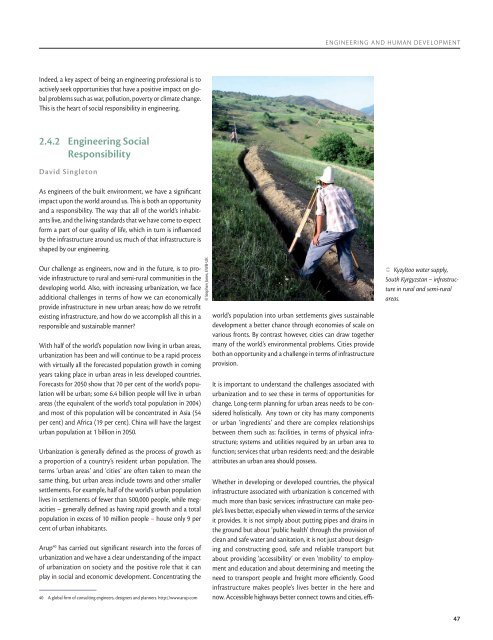Engineering: issues, challenges and opportunities for development ...
Engineering: issues, challenges and opportunities for development ...
Engineering: issues, challenges and opportunities for development ...
Create successful ePaper yourself
Turn your PDF publications into a flip-book with our unique Google optimized e-Paper software.
ENGINEERING AND HUMAN DEVELOPMENTIndeed, a key aspect of being an engineering professional is toactively seek <strong>opportunities</strong> that have a positive impact on globalproblems such as war, pollution, poverty or climate change.This is the heart of social responsibility in engineering.2.4.2<strong>Engineering</strong> SocialResponsibilityDavid SingletonAs engineers of the built environment, we have a significantimpact upon the world around us. This is both an opportunity<strong>and</strong> a responsibility. The way that all of the world’s inhabitantslive, <strong>and</strong> the living st<strong>and</strong>ards that we have come to expect<strong>for</strong>m a part of our quality of life, which in turn is influencedby the infrastructure around us; much of that infrastructure isshaped by our engineering.Our challenge as engineers, now <strong>and</strong> in the future, is to provideinfrastructure to rural <strong>and</strong> semi-rural communities in thedeveloping world. Also, with increasing urbanization, we faceadditional <strong>challenges</strong> in terms of how we can economicallyprovide infrastructure in new urban areas; how do we retrofitexisting infrastructure, <strong>and</strong> how do we accomplish all this in aresponsible <strong>and</strong> sustainable manner?With half of the world’s population now living in urban areas,urbanization has been <strong>and</strong> will continue to be a rapid processwith virtually all the <strong>for</strong>ecasted population growth in comingyears taking place in urban areas in less developed countries.Forecasts <strong>for</strong> 2050 show that 70 per cent of the world’s populationwill be urban; some 6.4 billion people will live in urbanareas (the equivalent of the world’s total population in 2004)<strong>and</strong> most of this population will be concentrated in Asia (54per cent) <strong>and</strong> Africa (19 per cent). China will have the largesturban population at 1 billion in 2050.Urbanization is generally defined as the process of growth asa proportion of a country’s resident urban population. Theterms ‘urban areas’ <strong>and</strong> ‘cities’ are often taken to mean thesame thing, but urban areas include towns <strong>and</strong> other smallersettlements. For example, half of the world’s urban populationlives in settlements of fewer than 500,000 people, while megacities– generally defined as having rapid growth <strong>and</strong> a totalpopulation in excess of 10 million people – house only 9 percent of urban inhabitants.Arup 40 has carried out significant research into the <strong>for</strong>ces ofurbanization <strong>and</strong> we have a clear underst<strong>and</strong>ing of the impactof urbanization on society <strong>and</strong> the positive role that it canplay in social <strong>and</strong> economic <strong>development</strong>. Concentrating the40 A global firm of consulting engineers, designers <strong>and</strong> planners. http://www.arup.com© Stephen Jones, EWB-UKworld’s population into urban settlements gives sustainable<strong>development</strong> a better chance through economies of scale onvarious fronts. By contrast however, cities can draw togethermany of the world’s environmental problems. Cities provideboth an opportunity <strong>and</strong> a challenge in terms of infrastructureprovision.It is important to underst<strong>and</strong> the <strong>challenges</strong> associated withurbanization <strong>and</strong> to see these in terms of <strong>opportunities</strong> <strong>for</strong>change. Long-term planning <strong>for</strong> urban areas needs to be consideredholistically. Any town or city has many componentsor urban ‘ingredients’ <strong>and</strong> there are complex relationshipsbetween them such as: facilities, in terms of physical infrastructure;systems <strong>and</strong> utilities required by an urban area tofunction; services that urban residents need; <strong>and</strong> the desirableattributes an urban area should possess.Whether in developing or developed countries, the physicalinfrastructure associated with urbanization is concerned withmuch more than basic services; infrastructure can make people’slives better, especially when viewed in terms of the serviceit provides. It is not simply about putting pipes <strong>and</strong> drains inthe ground but about ‘public health’ through the provision ofclean <strong>and</strong> safe water <strong>and</strong> sanitation, it is not just about designing<strong>and</strong> constructing good, safe <strong>and</strong> reliable transport butabout providing ‘accessibility’ or even ‘mobility’ to employment<strong>and</strong> education <strong>and</strong> about determining <strong>and</strong> meeting theneed to transport people <strong>and</strong> freight more efficiently. Goodinfrastructure makes people’s lives better in the here <strong>and</strong>now. Accessible highways better connect towns <strong>and</strong> cities, effi- Kyzyltoo water supply,South Kyrgyzstan – infrastructurein rural <strong>and</strong> semi-ruralareas.47

















